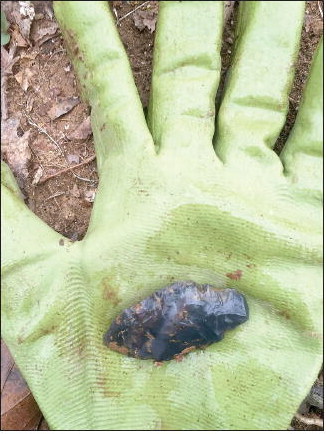editorials


A Chunk of Black Flint
For a month now, I’ve stood on the back deck and watched the backhoes and bulldozers push dirt around on the lot next door to our house. A couple from the Atlanta area recently purchased the property and hired an excavating crew to come out, cut a bunch of trees down, and level the property where a house will soon be positioned. Where once a lush forest of magnificent hardwoods and towering pines stood, there’s now a mud slick, due in part to the five inches of rain we got last week in Northwest Georgia.
Like a moth to a flame, I’m drawn to our soon-to-be neighbor’s freshly- turned earth. I spent close to a half hour today walking a serpentine pattern between our property and theirs with my eyes locked on the soil. I returned home with a chunk of black flint the size of a baseball and lots of sharp, shiny pieces showcasing worked divots.
I’ve been an avid arrowhead hunter since I was a young girl, always probing the dirt before me looking for pieces of rock that look different — slicker and more pointed — than the others. Perhaps I inherited my desire to search for Indian relics from my father, Herman Lanier, who was an accomplished arrowhead hunter and collector. When he would return home from a weekend at the hunting club, his pockets often revealed dozens of worked flint chips. He accumulated a large collection of Native American projectile points, and after his death my family divided the rocky relics to keep as reminders of him and his life.
I’ve found lots of pieces, but I didn’t find a complete, unbroken arrowhead until twenty years ago, and I found it right here on this chunk of land we call home. I happened to look down at the base of a pine tree and there it was — as if it wanted me to find it. I still have it. It is dark gray with sharp, scalloped edges and no stem. It’s a little smaller than a tube of ChapStick. My husband was mowing grass when I found it and screamed.
“I heard you yell, and I knew right away that it wasn’t a snake,” he said later. “When I looked up from the lawn mower and saw you smiling and jumping up and down, I knew you had found a perfect arrowhead.”
Looking for projectile points is somewhat of an addiction, or it is for me. There’s just something about holding history in the palm of your hand — touching something an ancient Georgian touched many, many moons ago. And that’s why I can’t stop myself from sneaking over a few feet onto the neighbor’s property to hunt for them now that the top layer of soil has been disturbed and we’ve had rain. Yes, I know it is wrong to trespass. I liken it to digging up wildflowers from the side of the road, and by the way, I’ve done my share of that, too. Professional collectors, archaeologists, and historians will tell you in a heartbeat that referring to all of these stone tips as “arrowheads” is fundamentally wrong. A more accurate term is “projectile point” or “PPK,” which stands for projectile points and knives. I grew up calling them all “arrowheads,” and I refer to all tissues as Kleenex and all carbonated beverages as Cokes. It’s a Southern thing.
This weekend, as thousands of children grab their baskets and head out to hunt for Easter eggs, I’ll probably venture into the backyard down by the creek — and just a few feet onto the adjacent property — to hunt for ancient arrowheads. Maybe I’ll find one and maybe I won’t, but the hunt will continue forever.









